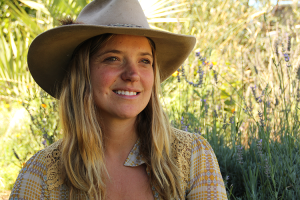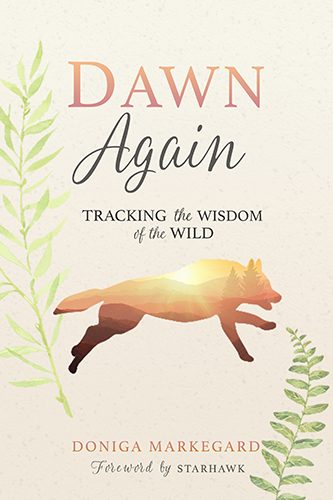This fall we’ll publish Dawn Again: Tracking the Wisdom of the Wild, by Doniga Markegard.  We’re excited about this book (Starhawk is writing the foreword!!), a memoir that traces Doniga’s life from the time she was a teenager seeking direction and meaning, through her time at the Wilderness Awareness School in the Pacific Northwest, from her studies with Lakota elder Gilbert Tatanka Mani, to tracking mountain lions along California’s rugged coast, to falling in love with a rancher named Erik and starting a life and a family with him. Doniga’s understanding of the natural world, and the lessons it holds for all of us make this memoir a must-read for anyone longing for a deeper connection with nature. When you order Dawn Again through our pre-sale, you get access to a thirty-minute long audio file called Tracking for Beginners, in which Doniga offers tips and advice so you can get started right now, no matter where you are.
We’re excited about this book (Starhawk is writing the foreword!!), a memoir that traces Doniga’s life from the time she was a teenager seeking direction and meaning, through her time at the Wilderness Awareness School in the Pacific Northwest, from her studies with Lakota elder Gilbert Tatanka Mani, to tracking mountain lions along California’s rugged coast, to falling in love with a rancher named Erik and starting a life and a family with him. Doniga’s understanding of the natural world, and the lessons it holds for all of us make this memoir a must-read for anyone longing for a deeper connection with nature. When you order Dawn Again through our pre-sale, you get access to a thirty-minute long audio file called Tracking for Beginners, in which Doniga offers tips and advice so you can get started right now, no matter where you are.
We had a chance to ask Doniga some questions about Dawn Again. Here’s our conversation:
When you think back to where you were in your life when you began learning to track, what kind of road might you have followed if tracking and wilderness studies had not presented itself as an option?
That is an interesting question. I discovered tracking when I was searching for meaning in my life and a direction where I could feel part of the solution to some of the destructive things I saw happening around me. As a child I would often ride my horse on logging roads and witness an entire hillside clearcut. When I began traveling the county and seeing crop dusters spraying chemicals on long rows of monocrops I became further disillusioned. I had grown up close to nature and the beauty of rivers and trees. It was not until I began tracking that I connected the pleasures I felt or fully understood that the life I experienced growing up was being threatened by over extraction of resources. I think if I had not discovered tracking I may have followed what the people around me were doing instead of following my heart. It is hard to say where I would have ended up because my life took so many turns, yet I was always led back to nature.
What do you think Gilbert Tatanka Mani saw in you that made him want to work with you?
Gilbert did not just mentor anyone who came along. Some people would visit searching for spirituality and he would remain silent. He had a way of knowing what stories and lessons to share at just the right moment. I think what he first saw in me was a passion for learning everything about nature and he admired that. At first he did not pay too much attention but taught me small things such as how to make prayer ties or a sacred song. When he would share something with me I would immediately take it on in my life and practice it daily. It was this dedication that he saw in me and led him to share more. When I would tell Gilbert what I learned and stories about my time in nature he would share more. This grew to a very deep spiritual relationship, one that I had not expected going in, yet emerged in the most natural way.
You kept extensive tracking journals that you were able to go back to in writing this memoir. What went through your mind as you pored over those?
I loved looking back at my old tracking journals. It was like peering back in time to the first discoveries of the stories that are all around us. The maps I drew immediately brought up vivid memories of the places I frequently tracked. I could almost smell the cottonwood buds and hear the rivers and feel the rocky sand beneath my feet.
What has tracking brought to your life?
Tracking has brought a deeper sense of my own connection to everything around me. It has also brought me a deeper connection to myself. When tracking an animal I put myself in the past, present and future in order to gain clues about the animal, what it was doing, where it was going, when it passed by and why the animal was moving the way it was moving. When I track I ask a lot of questions. These types of questions, who, what, when, where, why and how can be applied to anything in my life. Solving mysteries of tracking can convert to problem solving at my own ranch. Tracking also brought me a very keen sense of observation. While tracking I am constantly looking at the natural cycles around me to take in the bigger picture of the story. Now that I am practicing regenerative agriculture, that keen sense of observation has been key to making good decisions for our family and our land.
 What did you learn about your own experiences in tracking, ranching, and raising a family by writing Dawn Again?
What did you learn about your own experiences in tracking, ranching, and raising a family by writing Dawn Again?
Writing Dawn Again provided me with a time to reflect. I think often times people do not take the time to do that in their lives and they may keep moving forward without learning the lessons from the past. Writing the book also gave me an opportunity to be thankful for the gifts I have been given. I felt so grateful for the lessons of nature, the mentors in my life and my family that have all shaped who I am and the outcome of what my life has become. Often when I was writing and thinking very hard about how to approach a chapter or a subject I would do research of things that were already written, but that did not give me the feeling that I was complete about my writing. What helped me to round out my stories of the past was when I walked outside and interacted with nature, or sat down and had a conversation about the subject with my husband, children or friends. One time I was writing a story about a coyote and I walked out my front door and a coyote was standing up on the ridge. When I was writing I was paying very close attention to everything around me, just like tracking I was looking into the past, present and future through all of my senses. What really came out when I was writing was the less tangible sense of instinct. I just got into a zone, like when I trail an animal. My fingers moved and not many thoughts went through my head as the words came on the screen.
See and hear more from Doniga Markegard here on the San Francisco Exploratorium website, where Doniga is part of a permanent exhibit called Listen.
will be published November 1, 2017. Our pre-sale is on now, through the summer. You can follow Doniga Markegard on Instagram to see nature through her eyes, and to glimpse some artifacts of her tracker past.



Doniga is an amazing young woman. She has a gentle way about her, yet is clearly a woman used to hard physical work, as talented working with animals as she is dealing with her children and husband, all of whom are examples of people close to the land and animals. My wife and I look forward to reading her life story.